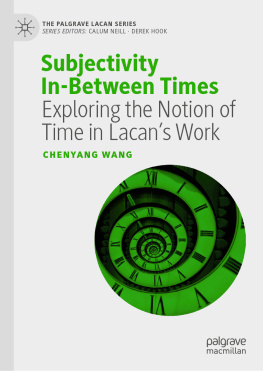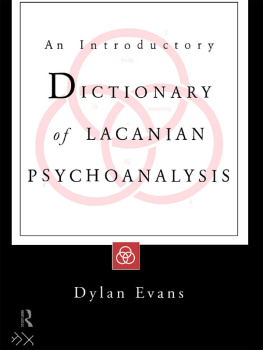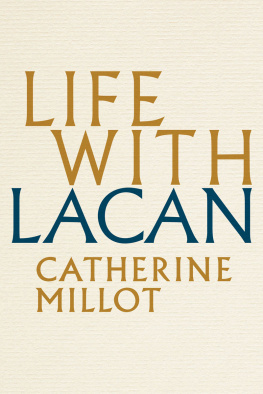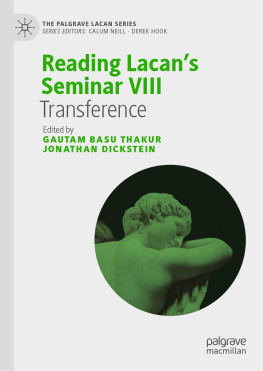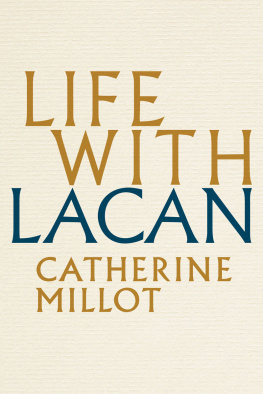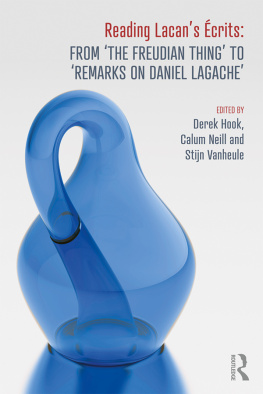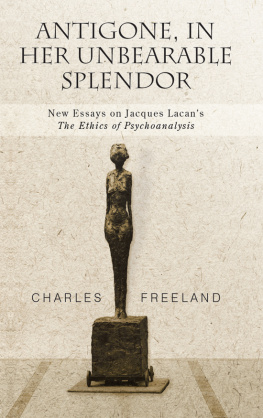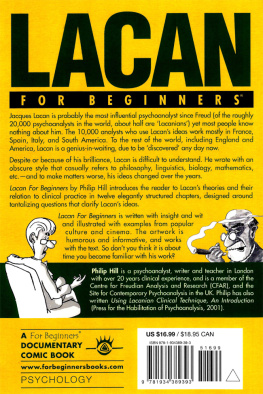The Palgrave Lacan Series
Series Editors
Calum Neill
Edinburgh Napier University, Edinburgh, UK
Derek Hook
Duquesne University, Pittsburgh, USA
Jacques Lacan is one of the most important and influential thinkers of the 20th century. The reach of this influence continues to grow as we settle into the 21st century, the resonance of Lacans thought arguably only beginning now to be properly felt, both in terms of its application to clinical matters and in its application to a range of human activities and interests. The Palgrave Lacan Series is a book series for the best new writing in the Lacanian field, giving voice to the leading writers of a new generation of Lacanian thought. The series will comprise original monographs and thematic, multi-authored collections. The books in the series will explore aspects of Lacans theory from new perspectives and with original insights. There will be books focused on particular areas of or issues in clinical work. There will be books focused on applying Lacanian theory to areas and issues beyond the clinic, to matters of society, politics, the arts and culture. Each book, whatever its particular concern, will work to expand our understanding of Lacans theory and its value in the 21st century.
More information about this series at http://www.palgrave.com/gp/series/15116
Chenyang Wang
Department of Psychosocial Studies, Birkbeck College, University of London, London, UK
The Palgrave Lacan Series
ISBN 978-3-030-26097-2 e-ISBN 978-3-030-26098-9
https://doi.org/10.1007/978-3-030-26098-9
The Editor(s) (if applicable) and The Author(s), under exclusive license to Springer Nature Switzerland AG 2019
This work is subject to copyright. All rights are solely and exclusively licensed by the Publisher, whether the whole or part of the material is concerned, specifically the rights of translation, reprinting, reuse of illustrations, recitation, broadcasting, reproduction on microfilms or in any other physical way, and transmission or information storage and retrieval, electronic adaptation, computer software, or by similar or dissimilar methodology now known or hereafter developed.
The use of general descriptive names, registered names, trademarks, service marks, etc. in this publication does not imply, even in the absence of a specific statement, that such names are exempt from the relevant protective laws and regulations and therefore free for general use.
The publisher, the authors and the editors are safe to assume that the advice and information in this book are believed to be true and accurate at the date of publication. Neither the publisher nor the authors or the editors give a warranty, expressed or implied, with respect to the material contained herein or for any errors or omissions that may have been made. The publisher remains neutral with regard to jurisdictional claims in published maps and institutional affiliations.
Cover illustration: DigiPub/gettyimages
This Palgrave Macmillan imprint is published by the registered company Springer Nature Switzerland AG
The registered company address is: Gewerbestrasse 11, 6330 Cham, Switzerland
Acknowledgements
I want to express my gratitude to a number of individuals that, in their own ways and with different degrees of engagements, have accompanied me throughout the intellectual journey that makes the present book possible. First and foremost, I would like to thank my Ph.D. supervisors, Professor Stephen Frosh and Professor Maria Aristodemou. Their guidance and encouragement helped me complete my doctoral dissertation as the first draft of this book. I wish to thank the intellectual support of my colleagues during my study at the Department of Psychosocial Studies, Birkbeck College, University of London. I enjoyed and benefited from our numerous discussions of philosophy, psychoanalysis and social theory. I also want to thank the Centre for Freudian Analysis and Research (CFAR) in London for cultivating an exceptional intellectual space, from where many ideas in the present book took shape.
In addition, I thank Derek Hook and Calum Neill for their appreciation of my work which motivated me to further develop my dissertation into the present book. A special thanks to Joanna ONeill at Palgrave Macmillan for the editorial support. An earlier version of part of Chapter 4 was previously published as From Timelessness to Otherness: The Articulation of Symbolic Time in Jacques Lacans Work, Vestigia: International Network of Psychoanalytic Practices , Vol. 2, No. 1, 2019. It is reprinted here with permission from the publisher. Revised sections of Chapter 6 will appear in I Will Have Lacked: Rethinking Sexual Difference and Sexed Subjectivity through the Lacanian Temporal Relationality, Studies in Gender and Sexuality , Vol, 20. I thank Katie Gentile, Stephen Hartman and Jeff Jackson for making the necessary arrangment.
Finally, my heartfelt thanks to my parents for their unconditional support, and to Jing, whose love and company have sustained me during this project. This book is dedicated to them.
List of Figures
Fig. 3.1 Graph of the psychic apparatus. Reprinted from Freud, S. (1900). The Interpretation of Dreams (p. 538). In S.E. IV
Fig. 3.2 Graph of the drive movement. Reprinted from Lacan, J. (1998). The Seminar of Jacques Lacan, Book XI: The Four Fundamental Concepts of Psychoanalysis, 1964 (p. 178) (J.-A. Miller, Ed.). Translated by Alan Sheridan. New York: W. W. Norton
Fig. 3.3 Graph of the subject, the erogenous zone and the unconscious. Self-made copy of the original image from Lacan, J. (1998). The Seminar of Jacques Lacan, Book XI: The Four Fundamental Concepts of Psychoanalysis, 1964 (p. 187) (J.-A. Miller, Ed.). Translated by Alan Sheridan. New York: W. W. Norton
Fig. 5.1 Schema L. Reprinted from Lacan, J. (1988b). The Seminar of Jacques Lacan, Book II: The Ego in Freuds Theory and in the Technique of Psychoanalysis, 19541955 (p. 243) (J.-A. Miller, Ed.). Translated by Sylvana Tomaselli. London and New York: W. W. Norton
Fig. 5.2 Schema L divided. Self-made
Fig. 6.1 Graph of Lacans example of the future anterior. Self-made
Fig. 6.2 Formulas of sexuation. Reprinted from Lacan, J. (1999). The Seminar of Jacques Lacan, Book XX: On Feminine Sexuality, the Limits of Love and Knowledge, 19721973 (p. 78) (J. Miller, Ed.). Translated by Bruce Fink. New York: W. W. Norton

